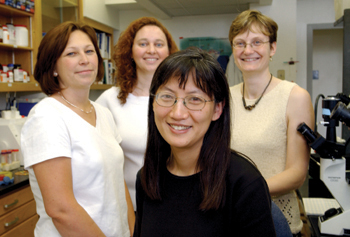
Jin Chen, M.D., Ph.D., assistant professor of Medicine, Cancer Biology, and Cell and Developmental Biology, foreground, led a study identifying a new factor that controls the formation of new blood vessels. Her research team included, left to right, Donna Hicks, Chen lab manager; Dana Brantley-Sieders, Ph.D., research instructor in the Chen lab; and collaborator Ambra Pozzi, Ph.D., assistant professor of Medicine and Cancer Biology. Photo by Dana Johnson
Emergency department now requiring co-pay
Vanderbilt Medical Center’s emergency department will now require a co-payment or deposit following treatment and prior to discharge from the emergency department.
The new policy affects the emergency departments in both Vanderbilt University Medical Center and Vanderbilt Children’s Hospital.
For Vanderbilt University employees covered by one of the University health care plans, the change means paying a $100 co-pay upon a visit to the emergency department. For those individuals who do not have insurance, a $300 deposit will be collected.
Vanderbilt’s emergency departments had more than 70,000 visits last year.
Brent Lemonds, R.N., administrative director of Emergency Services, said the change reflects policy followed at most hospitals.
“Insurance companies require that we make an attempt to collect co-pays and deductibles to offset some expense of the care provided,” Lemonds said.
Lemonds suggested that those seeking care for non-emergency complaints, do so from their primary physician.
“Emergency department care is an expensive alternative,” he explained. “Uninsured patients should look into care provided by Bridges to Care.”
Emergency department patient financial services representatives have been busy receiving training for the new system, which went into effect on May 17.
Tina Williams, manager of admitting and emergency registration, said the staff would work to advocate on behalf of patients.
“By having dedicated staff to man the discharge stations during peak hours, we can help answer patient questions regarding alternative clinical care within the community,” Williams said. “We certainly want to be an advocate for patients.”













